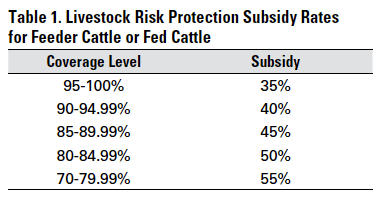Opening Growth Possible: Bagley Risk Management Approaches
Opening Growth Possible: Bagley Risk Management Approaches
Blog Article
Comprehending Livestock Threat Security (LRP) Insurance Coverage: A Comprehensive Guide
Navigating the world of livestock danger defense (LRP) insurance policy can be an intricate endeavor for many in the agricultural market. This sort of insurance policy uses a safety and security web against market changes and unforeseen situations that can influence animals manufacturers. By comprehending the ins and outs of LRP insurance coverage, manufacturers can make educated choices that might secure their procedures from financial threats. From just how LRP insurance coverage works to the various insurance coverage alternatives readily available, there is much to discover in this detailed guide that might possibly form the method animals producers approach danger monitoring in their organizations.

How LRP Insurance Works
Sometimes, recognizing the mechanics of Livestock Danger Protection (LRP) insurance policy can be complex, however breaking down just how it works can provide quality for herdsmans and farmers. LRP insurance policy is a threat administration tool created to protect livestock manufacturers versus unexpected price decreases. It's crucial to keep in mind that LRP insurance policy is not a revenue guarantee; rather, it concentrates only on cost danger defense.
Eligibility and Insurance Coverage Options

When it comes to coverage choices, LRP insurance coverage offers producers the adaptability to choose the coverage degree, protection duration, and recommendations that best suit their risk administration demands. By comprehending the qualification requirements and insurance coverage alternatives offered, livestock producers can make enlightened decisions to manage risk successfully.
Benefits And Drawbacks of LRP Insurance Policy
When evaluating Animals Threat Protection (LRP) insurance coverage, it is essential for livestock producers to evaluate the benefits and downsides integral in this risk monitoring tool.

One of the main benefits of LRP insurance policy is its ability to supply security versus a decline in livestock rates. Furthermore, LRP insurance provides a degree of versatility, permitting producers to tailor protection levels and plan periods to suit their certain requirements.
Nevertheless, there are likewise some drawbacks to take into consideration. One limitation of LRP insurance coverage is that it does not safeguard against all kinds of threats, such as condition break outs or all-natural disasters. In addition, premiums can often be expensive, particularly for producers with big livestock herds. It is critical for producers to carefully evaluate their private risk direct exposure and financial scenario to establish if click here to find out more LRP insurance policy is the right threat administration tool for their operation.
Recognizing LRP Insurance Premiums

Tips for Maximizing LRP Benefits
Making best use of the advantages of Animals Threat Protection (LRP) insurance coverage calls for calculated planning and proactive risk administration - Bagley Risk Management. To take advantage of your LRP insurance coverage, consider the following suggestions:
Regularly Examine Market Conditions: Keep educated concerning market trends and price variations in the animals market. By keeping an eye on these elements, you can make educated choices about when to acquire LRP insurance coverage to secure against possible losses.
Establish Realistic Insurance Coverage Levels: When choosing coverage degrees, consider your manufacturing expenses, market price of animals, and possible dangers - Bagley Risk Management. Establishing sensible coverage degrees guarantees that you are effectively secured without overpaying for unneeded insurance
Diversify Your Insurance Coverage: As opposed to counting exclusively on LRP insurance, consider expanding your threat management strategies. Integrating LRP with various other risk administration tools such as futures agreements or alternatives can give thorough protection versus market uncertainties.
Testimonial and Adjust Insurance Coverage Consistently: As market problems change, regularly review your LRP protection to guarantee it straightens with your present threat direct exposure. Readjusting protection levels and timing of purchases can aid enhance your danger security technique. By complying with these pointers, you can make the most of the benefits of LRP insurance coverage and protect your livestock procedure versus unanticipated threats.
Conclusion
To conclude, livestock danger security (LRP) insurance coverage is a valuable device for farmers to manage the monetary dangers related to their livestock procedures. By understanding just how LRP functions, eligibility and coverage alternatives, as well as the advantages and disadvantages of this insurance, farmers can make informed decisions to shield their livelihoods. By thoroughly considering LRP premiums and implementing methods to take full advantage of advantages, farmers can minimize possible losses and make certain the sustainability of their operations.
Livestock manufacturers interested in obtaining Livestock Threat Defense (LRP) insurance policy can explore a range of qualification criteria and protection alternatives tailored to their details animals operations.When it comes to coverage alternatives, LRP insurance policy uses manufacturers the adaptability to pick the insurance coverage level, coverage period, and recommendations that ideal match their danger monitoring requirements.To realize the complexities of Livestock Risk Defense (LRP) insurance coverage totally, understanding the variables affecting LRP insurance costs is important. LRP insurance policy costs are determined by numerous components, consisting of the insurance coverage degree selected, the expected price of livestock at the end of the insurance coverage period, the kind of livestock being guaranteed, and the length of the protection period.Evaluation and Change Insurance Coverage Frequently: As market conditions alter, periodically examine your LRP insurance coverage to ensure it lines up with your present you could look here risk direct exposure.
Report this page